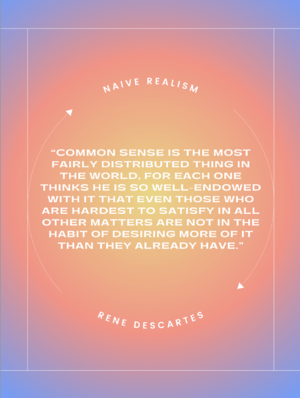The Objectivity Assumption
We often think what we perceive is an accurate, objective reflection of reality although it is a construct of our mind. This misperception is often call the "bias blind spot" or "naïve realism" and it is a prevalent cognitive bias in society. This bias is so pervasive it is often acocmpanyed by a projected bias the assumed similarity bias where people believe that their unique construction of the world around them is how others also perceive the world around them.
Contrary to the "objective reflection" assumption, perceptions are not precise copies of the world around us. Sensation is an abstraction, not a replication, of reality. The brain’s circuits construct an internal representation of external physical events after first analyzing various features of those events. When we hold an object in our hands, the shape, movement, and texture of the object are simultaneously analyzed in different brain regions according to the brain’s own rules, and the results are integrated into a conscious experience.
The easiest example of this is colour perception. We can argue that colors are not real—they are “synthesized” by our brain to distinguish light with different wavelengths. While rods give us the ability to detect the presence and intensity of light (and thus allow our brain to construct the picture of the world around us), specific detection of different wavelengths through independent channels gives our view of the world additional high resolution. For instance, red and green colors look like near identical shades of grey in black and white photos. Why certain wavelengths are paired with certain colors remains a mystery. Technically, color is an illusion created by our brain. Therefore, it is not clear if other animals see colors the same way we see them. It is likely that, due to shared evolutionary history, other vertebrates see the world colored similarly to how we see it. But color vision is quite common across the vast animal kingdom: insects, arachnids, and cephalopods are able to distinguish colors.
There are several reasons why this assumption is so prevalent. First, it's a natural outcome of how our brains process information. Our brains take in information from our senses and construct a model of the world that feels objective and real to us. This model helps us navigate the world and make decisions, so it's beneficial for our survival and success.
Second, acknowledging that our perceptions are subjective can be uncomfortable and can cause cognitive dissonance. It introduces uncertainty and can challenge our sense of self and our beliefs. Therefore, we often resist acknowledging our biases and maintain the belief in our objectivity.
Finally, societal norms and structures often reinforce the assumption of objectivity through the Status Quo Bias reaffirming the idea of a consensus reality. For example, in many cultures, people are rewarded for being confident and certain, which can discourage people from questioning their own perceptions and beliefs.
However, it's important to note that while we all have biases and our perceptions are inherently subjective, this doesn't mean that all perceptions are equally valid or that objective truth doesn't exist. It simply means that achieving a more objective understanding of the world often requires us to actively acknowledge and challenge our cognitive biases.
